Argentina’s Ministry of Educati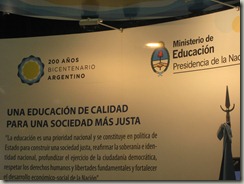 on’s slogan is: una educación de calidad para una sociedad más justa…a quality education for a more just society. For the last two weeks, the program took all of us to Buenos Aires, Argentina to conclude the “structured” academic part of the program (for the next month each student conducts his or her own independent study project). It was incredible to be able to see another Latin American country’s philosophy of education, yet another country that had experienced a dictatorship during the 70s and 80s, and another country with varying degrees of neoliberalism and globalization.
on’s slogan is: una educación de calidad para una sociedad más justa…a quality education for a more just society. For the last two weeks, the program took all of us to Buenos Aires, Argentina to conclude the “structured” academic part of the program (for the next month each student conducts his or her own independent study project). It was incredible to be able to see another Latin American country’s philosophy of education, yet another country that had experienced a dictatorship during the 70s and 80s, and another country with varying degrees of neoliberalism and globalization.
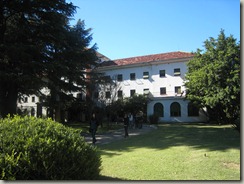
(Here’s one of their centers of torture during their dictatorship that we visited).
My general conclusion: Argentina is a much more creative country. Generalizations aren’t usually useful and in reality I don’t know that much about the complexities, intricacies or details of Chile’s or Argentina’s education system (and I think our director is a bit bias…he likes Argentina’s education system more so we got to see the “good stuff” in Argentina, while Chile’s program focused on the problems of its system).
Argentina has its issues. From 1976-1983 it had brutal dictator where more than 30,000 people “disappeared” (yes, the U.S. helped finance this one too). Neoliberalist policies started under the “liberal”government after the dictatorship (unlike in Chile where neoliberalism started during the 70s). Argentina has over 12 million students in school—50% of the schools in Buenos Aires are private. 18.5% of young people between 13 and 17 years old do not attend school. It has a huge issue with students repeating grades. Three out of every 10 adolescents are living in poverty.
But Argentina has been creative with its solutions to these issues and in many ways has been resistant to a neoliberal take over of its education---education is still very much a human right.
Argentina talks about the dictatorship. In Chile, schools use the language “military leader” to describe the dictatorship (and students don’t really learn much about this time…history seems to skip this period). Many Chileans are still supportive of the force Pinochet used and changes he made. But it’s not like that in Argentina.
In Argentina schools are named after teachers who disappeared during this time.
One school we visited was named Cancho Carranza. Ironically most of the students in the school are immigrants…but immigrants from countries like Paraguay, who also had their share of brutal dictators and disappeared persons.
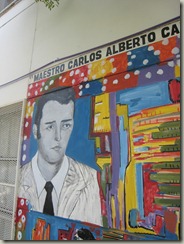
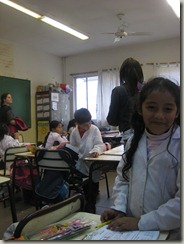
Schools also have plaques of the names of students and teachers who were murdered during the dictatorship. 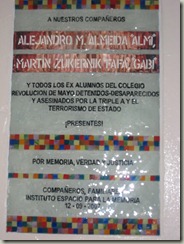 The plaque at a different school reads: To our co-works: Alejandro and Martin and all of the former students who were detained, disappeared, and assassinated during the terrorism of the state. Present! For memory, truth, and justice.
The plaque at a different school reads: To our co-works: Alejandro and Martin and all of the former students who were detained, disappeared, and assassinated during the terrorism of the state. Present! For memory, truth, and justice.
And students learn. all students learn too. My host mom was a first grade teacher and she told me that during the Day of Memory, she reads books that were banned during the dictatorship. Students learn about the Madres (de la Plaza de Mayo) who began to march every Thursday at the Plaza de Mayo (Plaza in front of the Government building) asking the government “where are our children?” Murals in schools have images of the mothers protesting and their famous scarves they wear on their heads…the scarves are actually the diapers of their disappeared children. 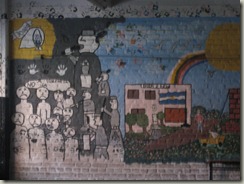
We had the opportunity to talk with one of the mothers, Juanita (she’s 96 years old) and participate in their weekly Thursday march. The Madres de La Plaza de Mayo is an incredible organization that continues to fight for justice in Argentina. The mothers have started a university, built preschools that emphasize the UN’s Rights of a Child, published tons of books, and they’ve created a following….I don’t think I’ve ever attended a protest/march where tourists come to watch and take photos.
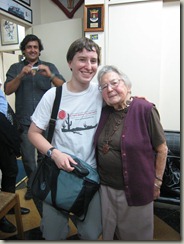
 And we also saw schools that are rethinking what’s an education. One school was trying to deal with students who are dropping out and/or repeating certain grades. So the community of these students came together to discuss what could be done…a school was created in a printing factory…they added a community radio…the school is part of the community center.
And we also saw schools that are rethinking what’s an education. One school was trying to deal with students who are dropping out and/or repeating certain grades. So the community of these students came together to discuss what could be done…a school was created in a printing factory…they added a community radio…the school is part of the community center. 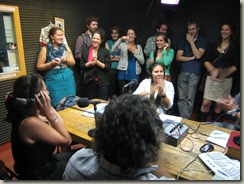 Another day we went to school that is dealing with issues of adolescent mothers and fathers. This school was started as the result of many requests from the community. They wanted a school that would let them continue to attend school…and have a place for their children. So there’s a center for the students’ babies and the teachers' children as well. They also have an emphasis on practical education—students after 2 years decide to study more intensely communication or cooking.
Another day we went to school that is dealing with issues of adolescent mothers and fathers. This school was started as the result of many requests from the community. They wanted a school that would let them continue to attend school…and have a place for their children. So there’s a center for the students’ babies and the teachers' children as well. They also have an emphasis on practical education—students after 2 years decide to study more intensely communication or cooking. 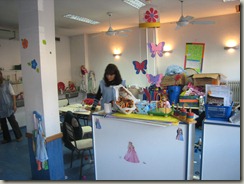
 And memory isn’t just something of the dictatorship. This was a mural we saw in the courtyard of the school for adolescent mothers and fathers. It’s a mural dedicated to Esteben, a young man who was a student at this school when he was shot to death.
And memory isn’t just something of the dictatorship. This was a mural we saw in the courtyard of the school for adolescent mothers and fathers. It’s a mural dedicated to Esteben, a young man who was a student at this school when he was shot to death. 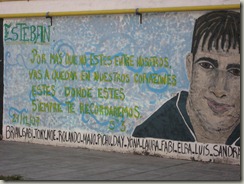 I think Argentina, a country that calls the specific dictatorship during the 70s and 80s as the “recent military dictatorship,” (because it has had five or six dictatorships in its 200 year history…it needs to specify which dictatorship is which)…recognizes that it needs to have a system of education that teaches how to create a more just society because the future of Argentina needs to look different than its past.
I think Argentina, a country that calls the specific dictatorship during the 70s and 80s as the “recent military dictatorship,” (because it has had five or six dictatorships in its 200 year history…it needs to specify which dictatorship is which)…recognizes that it needs to have a system of education that teaches how to create a more just society because the future of Argentina needs to look different than its past.











